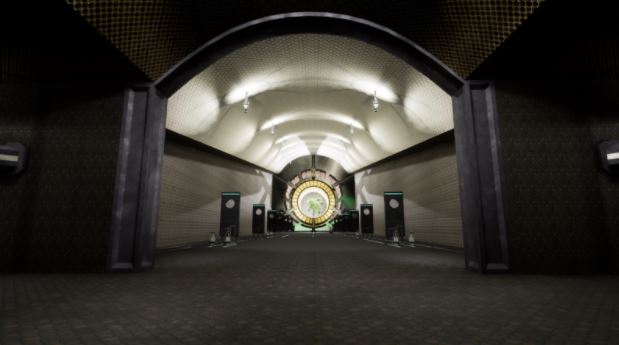The Long Gate, developed by David Shaw and published by Inductance, is a challenging puzzle game based on real-world technologies. It is more of an introduction to computer engineering and what kind of problems they come across in their lives. As a computer science major, I found the idea very enjoyable ; for the people who have interest in the area, it is a great opportunity to explore these fundamental ideas in computers.
As soon as the game starts, you are dropped into an unknown world where you feel like a small ant, turning on and off switches to discover what lies ahead. Right from the start you are given a “gadget” (it is not named in the game so I will call it a fake portal gun for the resemblance), it is a tool for you to interact with the environment. You have three paths to start from, each of them contains a different type of puzzle. At any time, you have the freedom to go back and try other paths the game offers to you. Having the freedom to do so is a good addition for a puzzle game since you may get stuck and want to visit another puzzle you were working on before. Warning: you will get stuck at some point. The puzzles are separated by two portals, blue and red. Through the blue portal you can access the first sequence of puzzles.
These puzzles are based on logic operators and as you progress through the levels, new elements like input/output through binary numbers and binary cycles are added to the ramped complexity of the puzzle. You are supposed to get the right input by moving around and/or/not statements, booting machines that read binary numbers and well, binary cycles. From time to time, you may need a good old pen and pencil to draw the schematics of the complex systems.

Because the game is in 3-D, just to see what is happening in a puzzle takes a substantial amount of time since you need to run around and understand the system as a whole. Once you figure out where the puzzle starts and the order you need to solve it, you can compartmentalize the puzzle and start working on it. The puzzles have a steep learning curve, they introduce the idea in the most simplest form and then expect you to put them in the context of the puzzle with other elements. For instance, at the fourth level you are required to input binary code into a machine, keep track of the cycles the system goes through and move around logic operators to get a single output. I don’t think the puzzles were undoable because of the steep curve, but they definitely required a moment to stop and think. If I was not familiar with the concepts, I would struggle even more to solve these puzzles.
In order to access other puzzles, you are required to fall into the red portal. In this new area the path diverges into two. But if you look ahead, you can see a machine which will start working by completing puzzles on both paths. You may be encouraged to solve these puzzles just to see what happens when the machine starts working.

Second sequence of puzzles is based on graphs. You need to produce the required graph by manipulating given waves with amplitude, addition, LPF (Low Pass Filter) and HPF (High Pass Filter) machines. The Long Gate provides a picture of your current graph and the required graph on your gadget which is very convenient. You can track your progress very easily by looking at it. First couple of introductory puzzles are fairly easy as usual, but the following puzzles have a similar learning curve to the first sequence of puzzles.

My high school AP courses weren’t enough to understand what it was exactly, so unless you are not majoring in computer engineering or physics, you will be counting on your instincts to solve these puzzles. I think the generosity of these puzzles compensate the difficulty a bit, they accept the produced wave if it is close enough to the solution. On the other hand, the last sequence of puzzles, circuit puzzles, are not so generous. You have to be precise with which circuits you want to connect and to do that you must have a good overview of the whole system. One switch can change the entire outcome of the system. Finding the right order can really test your limits, both emotionally and intellectually. Don’t worry though, you are accompanied with great music while playing the game so you just need to take a deep breath and not give in to the frustration. The grandiose interior design combined with soothing sci fi music might be the best part of the game. It creates a very peaceful atmosphere and helps you to focus on the task at hand.
I have to say, each time I solved even a small piece of the puzzles, it felt amazing. In a way, this game was Dark Souls of the puzzle games. Solving the first binary cycles puzzle is equivalent to killing Ludex Gundyr for the first time. Apparently, The Long Gate also has a story, however, I have not progressed enough to discover what it was exactly. Each time I completed a puzzle, I felt I was getting closer to starting that mysterious machine. Unfortunately, there were minor holdbacks while playing the game. Being in the first place, the lack of tutorial. In a game where only certain people can understand the elements of, a tutorial must be included to explain ideas and how they work a bit more in detail. Personally, I love when the games prepare an “invisible tutorial” for you, but in this game, I had no clue about what to do at certain points of the puzzles. At the third level of the first sequential puzzles, you are required to copy a binary code and output it to a machine by using your fake portal gun. I checked the controls menu, walked all the way back to the beginning to see if I missed something, and even started solving other puzzles to see if I was going to get the code by progressing in them. SPOILER: However, you are actually supposed to find the door behind the elevator and figure out how to use the 8×8 table to receive a binary input for your fake portal gun.

for your fake portal gun)
You might have some instincts to do all of these things, however, if you don’t know how to get to do them, it gets very frustrating. Even if you do figure out, there are bugs in the game to confuse you even more.
When I first saw this table, I could not get an output because the console where you are supposed to insert your fake portal gun got bugged so I thought I was on the wrong track. Most probably these bugs will be fixed and maybe more elaborated tips will be included in the future patches. I played the 1.0.2 version of the game, and from what I saw in the new 1.0.3 version update the developer worked on some of these issues. They added an easier mode for playing the game – more tips are shown, which will be used by the majority of the players for sure. I am also hoping to see a toggleable “2-D” view of the puzzles, since it would facilitate puzzle solving so much.
Creating a game where you solve puzzles about waves and logical operations made me think of this as a serious/educational game where the students can actually practice in a fun and challenging environment. However, for people who are not familiar with such concepts, this game will indeed seem confusing, even baffling. The game is for people who look for a pure challenge. And the current difficulty curve of the game is definitely not for players who are looking for casual puzzles. Aside from that, the developer needs to fix the bugs in the game, implement the feedback he receives from players, and maybe add more puzzles. At the moment, the game deserves 5/10.
Check Out The Long Gate Trailer:
The Long Gate is available for Steam on PC and Linux.
As an Amazon Associate we earn from qualifying purchases.
Steam Review
I am a game enthusiast who is planning to be a game designer in the future. I am open to any chit-chat about games, discuss games mechanics or talk about anything related to games! Contact me for any questions or comments!





More Stories
I AM FUTURE Review for PlayStation 5
PUBG: BLINDSPOT will be Launching on February 5th via Early Access
GTA Online: Money Fronts, HSW Race Bonuses, Free Hands-on Car Wash Property, Plus Much More